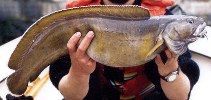Add your observation in Fish Watcher
| Native range | All suitable habitat | Point map | Year 2050 |

|
| This map was computer-generated and has not yet been reviewed. |
| Brosme brosme AquaMaps Data sources: GBIF OBIS |
Upload your photos and videos
Pictures | Videos | Google imageBrosme brosme
Picture by Østergaard, T.
Pictures | Videos | Google imageBrosme brosme
Picture by Østergaard, T.
Common names from other countries
Classification / Names Populärnamn | synonymer | Catalog of Fishes(Släkte, Arter) | ITIS | CoL | WoRMS | Cloffa
> Gadiformes (Cods) > Lotidae (Hakes and burbots)
Etymology: Brosme: Greek, brosomai, bibrosko = to eat up, to devour (Ref. 45335).
Etymology: Brosme: Greek, brosomai, bibrosko = to eat up, to devour (Ref. 45335).
Environment: milieu / climate zone / depth range / distribution range Ekologi
marina bottenlevande; havsvandrande (Ref. 51243); djupintervall 18 - 1000 m (Ref. 1371), usually 18 - 549 m (Ref. 1371). Temperate; 83°N - 37°N, 75°W - 57°E (Ref. 1371)
Utbredning Länder | FAO områden | Ekosystem | Förekomster | Point map | Utplanteringar | Faunafri
Northwest Atlantic: New Jersey to the Strait of Belle Isle and on the Grand Banks of Newfoundland. Rare at the southern tip of Greenland. Northeast Atlantic: off Iceland, in the northern North Sea, and along the coast of Scandinavia to the Murmansk Coast and at Spitzbergen.
Length at first maturity / Size / Vikt / Age
Maturity: Lm 53.3, range 50 - ? cm
Max length : 120 cm TL hane/ej könsbestämd; (Ref. 9988); common length : 50.0 cm TL hane/ej könsbestämd; (Ref. 1371); publicerad maxvikt: 30.0 kg (Ref. 9988); rapporterad maxålder: 20 år (Ref. 1371)
Max length : 120 cm TL hane/ej könsbestämd; (Ref. 9988); common length : 50.0 cm TL hane/ej könsbestämd; (Ref. 1371); publicerad maxvikt: 30.0 kg (Ref. 9988); rapporterad maxålder: 20 år (Ref. 1371)
Short description Bestämningsnycklar | Morfologi | Morfometri
Taggstrålar i ryggfenan (totalt) : 0; Mjukstrålar i ryggfenan (totalt) : 93 - 103; Mjukstrålar i analfenan: 62 - 75; Ryggkotor: 64 - 67. Barbel on present on chin, none on snout, its length equal to eye diameter. Color is variable; dorsally dark red-brown or green brown to yellow shading into pale color on belly. Young specimens may have six transverse yellow bands on sides. Vertical fins with dark margin rimmed with white.
Found in small shoals on rough, rock, gravel, or pebble bottoms. Generally keeps far from the shore, near the bottom, mostly between 150 and 450 m in the northeastern Atlantic, and between 18 and 550 m in the northwestern Atlantic. Occurs at a temperature range of 0°-10° C (Ref. 9988). Solitary or in small groups. Feeds on crustaceans and shellfishes, benthic fishes (flatfishes and gurnard) and even on starfishes. Preyed upon by seals (Ref. 9988). Sold fresh, frozen as fillets or dried salted. Eaten steamed, fried, broiled, boiled, microwaved and baked (Ref. 9988).
Life cycle and mating behavior Könsmognad | Reproduktion | Lek | Ägg | Fecundity | Larver
Spawns in shallower waters between 40-400 m, usually 100 to 200 m. Most important spawning grounds are located between Scotland and Iceland, from 200 to 500 m depth. In the Gulf of Maine, spawning grounds can be found in shallower waters (>50 m). Some individuals even spawn close inshore in Cape Cod, Provincetown Harbor and the Isles of Shoals (Ref. 1371).
Main reference
Upload your references | referenser | Koordinator | Medarbetare
Cohen, D.M., T. Inada, T. Iwamoto and N. Scialabba, 1990. FAO species catalogue. Vol. 10. Gadiform fishes of the world (Order Gadiformes). An annotated and illustrated catalogue of cods, hakes, grenadiers and other gadiform fishes known to date. FAO Fish. Synop. 125(10). Rome: FAO. 442 p. (Ref. 1371)
Threat to humans
Harmless
Human uses
Fiskeri: kommersiellt viktig; sportfisk: ja
FAO(fiskeri: produktion, species profile; publication : search) | FIRMS (Stock assessments) | FishSource | Sea Around Us
Ytterligare information
Population dynamics
Tillväxtparametrar
Max. ages / sizes
Length-weight rel.
Length-length rel.
Length-frequencies
Mass conversion
Rekrytering
Abundans
Tillväxtparametrar
Max. ages / sizes
Length-weight rel.
Length-length rel.
Length-frequencies
Mass conversion
Rekrytering
Abundans
Life cycle
Reproduktion
Könsmognad
Fecundity
Lek
Spawning aggregations
Ägg
Egg development
Larver
Larvdynamik
Reproduktion
Könsmognad
Fecundity
Lek
Spawning aggregations
Ägg
Egg development
Larver
Larvdynamik
Physiology
Body composition
Nutrients
Syreförbrukning
Swimming type
Simhastighet
Visual pigments
Fish sound
Diseases & Parasites
Toxicity (LC50s)
Body composition
Nutrients
Syreförbrukning
Swimming type
Simhastighet
Visual pigments
Fish sound
Diseases & Parasites
Toxicity (LC50s)
Genetics
Genetik
Heterozygosity
Ärftlighet
Genetik
Heterozygosity
Ärftlighet
Human related
Aquaculture systems
Vattenbruksprofiler
Avelslinjer
Ciguatera cases
Stamps, coins, misc.
Aquaculture systems
Vattenbruksprofiler
Avelslinjer
Ciguatera cases
Stamps, coins, misc.
Verktyg
Bio-Quiz | E-book | Fälthandbok | Bestämningsnycklar | Längdfördelnings-verktyg | Livshistorie-verktyg | Prickkarta | Classification Tree
| Catch-MSY |
Special reports
Download XML
Internet-källor
Aquatic Commons | BHL | Cloffa | Websites from users | Check FishWatcher | CISTI | Catalog of Fishes(Släkte, Arter) | DiscoverLife | ECOTOX | Faunafri | Fishtrace | GenBank(genome, nucleotide) | GloBI | GOBASE | | Google Books | Google Scholar | Google | IGFA World Record | MitoFish | Nationella databaser | Otolith Atlas of Taiwan Fishes | Offentliga akvarier | PubMed | Reef Life Survey | RFE Identification | Scirus | SeaLifeBase | Tree of Life | Wikipedia(Go, sök) | World Records Freshwater Fishing | Zoological Record
Estimates based on models
Preferred temperature (Ref. 115969): 0.5 - 7.7, mean 3.6 (based on 726 cells).
Phylogenetic diversity index (Ref. 82804): PD50 = 1.0000 [Uniqueness, from 0.5 = low to 2.0 = high].
Bayesian length-weight: a=0.00562 (0.00411 - 0.00770), b=3.08 (2.99 - 3.17), in cm Total Length, based on LWR estimates for this species (Ref. 93245).
Trofisk nivå (Ref. 69278): 3.9 ±0.3 se; based on diet studies.
Resiliens (Ref. 120179): Mellan, lägsta populationsfördubblingstid 1,4-4,4 år (K=0.08-0.16; tm=8-10; tmax=20; Fec=2 million).
Prior r = 0.45, 95% CL = 0.30 - 0.68, Based on 9 full stock assessments.
Fishing Vulnerability (Ref. 59153): High vulnerability (58 of 100).
Climate Vulnerability (Ref. 125649): Moderate vulnerability (44 of 100).




